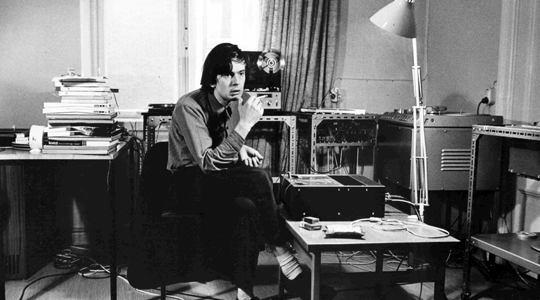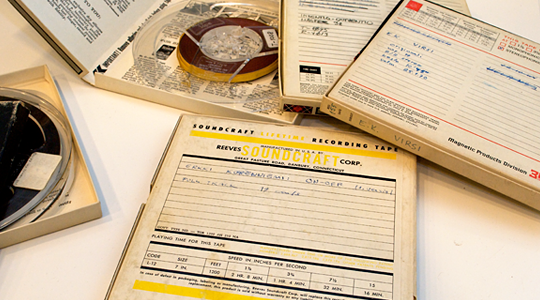Focus on Erkki Kurenniemi

CTM 2014 pays homage to Finnish composer, designer, artist, technologist, and visionary Erkki Kurenniemi, whose work and ideas have set the stage for electronic music in Finland. A pioneer of digital music technology, his revolutionary DIMI synthesizers built in the 1970s are believed to represent the first completely digital synthesizers, with real-time capabilities, that were ever made. In collaboration with Helsinki’s Kiasma Museum and the electronic studio of the University of Helsinki, CTM 2014 presents a multi-part programme to shed light on the life and work of this idiosyncratic artist and inventor.
CTM 2014 pays homage to Finnish composer, designer, artist, technologist, and visionary Erkki Kurenniemi, whose work and ideas have set the stage for electronic music in Finland. A pioneer of digital music technology, his revolutionary DIMI synthesizers built in the 1970s are believed to represent the first completely digital synthesizers, with real-time capabilities, that were ever made. In collaboration with Helsinki’s Kiasma Museum and the electronic studio of the University of Helsinki, CTM 2014 presents a multi-part programme to shed light on the life and work of this idiosyncratic artist and inventor.

Erkki Kurenniemi was born in 1941 and studied mathematics, theoretical and nuclear physics, and philosophy. Between 1961 and 1962 on he built the electronic music studio at the Institute of Musicology of the University of Helsinki, where he proceeded to create revolutionary electronic music instruments. He also developed custom instruments for seminal Scandinavian avant-garde artists such as M.A. Numinen, Osmo Lindeman, and Ralph Lundsten.
Sitting remotely at the European periphery as a neutral country situated between the Soviet Union and Western Europe before the fall of the Iron Curtain, the US considered Finland with some degree of suspicion, such that the country was often left without resources or easy channels for international collaboration. Due to such isolation, Kurenniemi was pushed to take new technological paths. His “Integrated Synthesizer” was the first digitally controlled synthesizer to be able to produce rhythm patterns, melodies, and harmonies in real time. Through the instruments of his subsequent DIMI series (from Digital Music Instrument), Kurenniemi elaborated his digital signal control methods, developed digital designs for sound synthesis, made use of digital memory, and explored the combination of sequencers with synthesizers. Yet the most outstanding features of these instruments are probably their innovative interfaces.
Kurenniemi went on to sketch out plans for a computer network that would allow multiple users to process musical information from networked terminals. Like many of his projects, however, it was never realized. In the same vein, Kurenniemi’s idea of an universal modular digital music studio, the DIMI-U, was way ahead of its time, anticipated today’s miniaturized virtual studios carried around the world in the laptops of many electronic producers.
“Departing from his contemporaries, Kurenniemi, envisioned the studio as an integrated whole of studio equipment and an automated music production facility, where sound production and control signals would be based on digital logic.” (Mikko Ojanen, musicologist)
Musically, Kurenniemi was deeply interested in algorithmic composition. Most of his instruments were capable of producing automated musical sequences without the intervention of a composer. Kurenniemi’s idea of an automated digital music are implied as early as 1963, in a piece entitled “On-Off”.

Kurenniemi’s technological enthusiasm necessarily gave his thought and experiments an interdisciplinary and integrative drive, which also connects him with pioneering work in early 20th century Russia, featured in CTM 2014’s Generation Z : ReNoise exhibition. Kurenniemi was not only a composer, artist, experimental film maker and instrument builder, he also worked as designer of industrial automation and robotic systems, and was active as a science educator. His intense interest in the transformational potential of technology may be seen as the main thread of his life and work. His infinite curiosity was similarly engaged with technological innovation and artistic speculation.
In recent years, a resurging interest in Erkki Kurenniemi’s work could be seen through its presentation at major exhibitions at dOCUMENTA (13), the Kunsthal Aarhus, as well as at the Helsinki Museum for Contemporary Art Kiasma. A comprehensive monograph is to be published by MIT Press in 2015. At the core of this interest sits Kurenniemi’s obsessive habit of documenting all aspects of his daily life, believing that by 2048, when quantum computers bear much greater computational powers, his mind should be recreated from these documents. Kurenniemi’s archival practise anticipated the new cultural techniques of self-staging, self-observation, and self-design emerging today through the interaction with online social networks and the integration of digital communication tools within our daily routines.
CTM’s programme dedicated to Erkki Kurenniemi comprises original sound pieces by the composer, and performances by Lucky Dragons, whose “Make a Baby” project strongly resonates with Kurenniemi’s “Sexophone”, as well as by Pan Sonic’s Mika Vainio who examines the sonic possibilities of the DIMI-A synthesizer in a separate festival evening.
At CTM 2014, Mikko Ojanen, a musicologist specializing in Kurenniemi’s body of work, presents Project QRZ, which opens the tape sound library Kurenniemi was building at the Electronic Music Studio of the University of Helsinki. Within the project, Ojanen, Tommi Keränen, and Swedish musician Carl Michael von Hausswolff will each perform their compositions created from Kurenniemi’s recordings.
A film screening programme, curated by Finnish film artist Mika Taanila, presents some of Kurenniemi’s experimental films, and explores his cinematographic collaborations. Taanila’s film portrait of Erkki Kurenniemi, “The Future is Not What it Used to Be”, will also be shown. Finally, lectures by Mikko Ojanen, Jari Suominen, and media-archaeologist Jussi Parrika will give in-depth insights into Kurenniemi’s music, machines, ideas, and life.
Presented in collaboration with Mikko Ojanen, Mika Taanila, and the Kiasma Museum for Contemporary Art in Helsinki.


